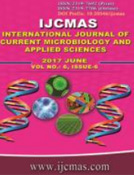


 National Academy of Agricultural Sciences (NAAS)
National Academy of Agricultural Sciences (NAAS)

|
PRINT ISSN : 2319-7692
Online ISSN : 2319-7706 Issues : 12 per year Publisher : Excellent Publishers Email : editorijcmas@gmail.com / submit@ijcmas.com Editor-in-chief: Dr.M.Prakash Index Copernicus ICV 2018: 95.39 NAAS RATING 2020: 5.38 |
The current study highlights the importance of entomopathogenic nematode (EPN), their bacterial symbionts and their combined efficacy along with Bacillus thuringiensis (Bt) in C. medinalis management. In the field experiment conducted at Thenthiruperai, Xenorhabdus bovienii+ Bt and X. japonica combined with Bt found to be more effective with 80.54 per cent and 79.37 per cent reduction in larval population over untreated control respectively. X. japonica combined with Bt and X. bovienii combined with Bt, were more effective with 69.38 per cent and 67.73 per cent reduction in leaf damage over control respectively. The native EPN S. kushidai showed 47.51 per cent reduction in leaf damage and it was 44.32 per cent in S. feltiae. In another experiment conducted at Anandanambikurichi revealed that X. bovienii+ Bt and the X. japonica + Bt proved superior efficacy with 72.59 and 69.33 per cent reduction in larval population over control respectively. S. kushidai KKM strain was better than S. feltiae as it could bring 55.77 per cent reduction in the larval population of C. medinalis. X. japonica + Bt and X. bovienii+Bt were found to be more effective with 71.23 per cent and 68.53 per cent reduction in leaf damage over untreated control respectively.
 |
 |
 |
 |
 |